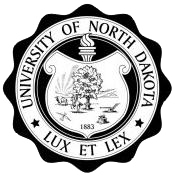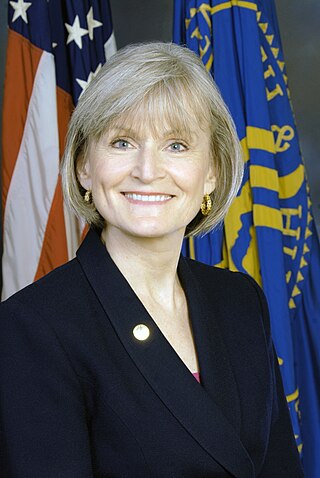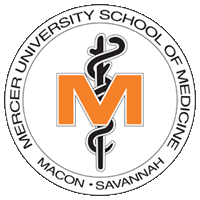
The University of North Dakota (UND) is a public research university in Grand Forks, North Dakota. It was established by the Dakota Territorial Assembly in 1883, six years before the establishment of the state of North Dakota.

The Indiana University School of Medicine (IUSM) is a major, multi-campus medical school located throughout the U.S. state of Indiana and is the graduate medical school of Indiana University. There are nine campuses throughout the state; the principal research, educational, and medical center is located on the campus of Indiana University Indianapolis. With 1,461 MD students, 195 PhD students, and 1,442 residents and fellows in the 2023–24 academic year, IUSM is the largest medical school in the United States. The school offers many joint degree programs including an MD/PhD Medical Scientist Training Program. It has partnerships with Purdue University's Weldon School of Biomedical Engineering, other Indiana University system schools, and various in-state external institutions. It is the medical school with the largest number of graduates licensed in the United States per a 2018 Federation of State Medical Boards survey with 11,828 licensed physicians.

The Medical University of South Carolina (MUSC) is a public medical school in Charleston, South Carolina. It opened in 1824 as a small private college aimed at training physicians and has since established hospitals and medical facilities across the state. It is one of the oldest continually operating schools of medicine in the United States and the oldest in the Deep South.

Semmelweis University is a research-led medical school in Budapest, Hungary, founded in 1769. With six faculties and a doctoral school it covers all aspects of medical and health sciences.

Mahidol University is an autonomous public research university in Thailand. The university was founded as part of Siriraj Hospital in 1888. It was first called the University of Medical Science in 1943, and has been recognized as Thailand's fourth public university. The university was renamed in 1969 by King Bhumibol Adulyadej for his father, Prince Mahidol of Songkhla, known as the "Father of Modern Medicine and Public Health in Thailand".
Oregon Health & Science University (OHSU) is a public research university focusing primarily on health sciences with a main campus, including two hospitals, in Portland, Oregon. The institution was founded in 1887 as the University of Oregon Medical Department and later became the University of Oregon Medical School. In 1974, the campus became an independent, self-governed institution called the University of Oregon Health Sciences Center, combining state dentistry, medicine, nursing, and public health programs into a single center. It was renamed Oregon Health Sciences University in 1981 and took its current name in 2001, as part of a merger with the Oregon Graduate Institute (OGI), in Hillsboro. The university has several partnership programs including a joint PharmD Pharmacy program with Oregon State University in Corvallis.
The University of North Texas Health Science Center at Fort Worth – HSC, Health Science Center, Health Science Center at Fort Worth – is an academic health science center in Fort Worth, Texas. It is part of the University of North Texas System and was founded in 1970 as the Texas College of Osteopathic Medicine, with its first cohort graduating in 1974. The Health Science Center consists of six schools with a total enrollment of 2,338 students (2022-23).

The Texas Tech University Health Sciences Center (TTUHSC) is a public medical school based in Lubbock, Texas, with additional campuses in Abilene, Amarillo, Dallas, and the Permian Basin. TTUHSC serves more than 100 counties in the western portion of Texas. The university is a separate institution from Texas Tech University; both universities are among five universities that are part of the Texas Tech University System. Texas Tech University Health Sciences Center El Paso, founded in 1969 as a branch campus of TTUHSC, became a separate institution in 2013.

The Brody School of Medicine at East Carolina University (BSOM) is a public medical school located in Greenville, North Carolina, United States. It offers a Doctor of Medicine program, combined Doctor of Medicine / Master of Public Health and Doctor of Medicine / Master of Business Administration programs, and standalone Doctor of Philosophy and Master of Public Health programs. Brody is a national leader in family medicine, ranking No. 1 in North Carolina and No. 2 nationally in the percentage of graduates who choose careers in family medicine, based on the 2017 American Academy of Family Physicians report on MD-granting medical schools. Brody ranks in the top 10 percent of U.S. medical schools for graduating physicians who practice in the state, practice primary care and practice in rural and underserved areas. Brody graduates currently practice in 83 of North Carolina's 100 counties.
The University of Kansas Medical Center, commonly referred to as KU Med or KUMC, is a medical campus for the University of Kansas. KU Med houses the university's schools of medicine, nursing, and health professions, with the primary health science campus in Kansas City, Kansas. Other campuses are located in Wichita and Salina, Kansas, and is connected with the University of Kansas Health System.
The University of Oklahoma College of Medicine is the medical school of the University of Oklahoma, located in Oklahoma City. The College of Medicine is part of the university's Health Sciences Center. It is one of only 150 medical schools in the United States that are fully accredited by the Liaison Committee on Medical Education and the only one located in the state of Oklahoma.
Drexel University College of Medicine is the medical school of Drexel University, a private research university in Philadelphia, Pennsylvania. The medical school represents the consolidation of two medical schools: Hahnemann Medical College, originally founded as the nation's first college of homeopathy, and the Woman's Medical College of Pennsylvania, the first U.S. medical school for women, which became the Medical College of Pennsylvania when it admitted men in 1970; these institutions merged in 1993, became affiliated with Drexel University College of Medicine in 1998, and were fully absorbed into the university in 2002. With one of the nation's largest enrollments for a private medical school, Drexel University College of Medicine is the second most applied-to medical school in the United States. It is ranked no. 83 in research by U.S. News & World Report.

The University of Kentucky College of Medicine is a medical school based in Lexington, KY at the University of Kentucky's Chandler Medical Center.

University Village is a neighborhood in Grand Forks, North Dakota. It is a part of the University of North Dakota (UND) campus and is located directly north of UND's central campus area. The property comprises 160 acres (0.65 km2) located on the banks of the meandering English Coulee directly off U.S. Highway 2. University Village has been developed as a commercial and residential neighborhood with the Ralph Engelstad Arena as the major anchor and has been called "the most valuable piece of real estate in North Dakota."
A.T. Still University (ATSU) is a private medical school based in Kirksville, Missouri, with a second campus in Arizona and third campus in Santa Maria, California. It was founded in 1892 by Andrew Taylor Still and was the world's first osteopathic medical school. It is accredited by the Higher Learning Commission. ATSU includes three campuses on 200 acres with seven schools and colleges.

Rocky Vista University (RVU) is a private, for-profit medical school with campus locations in Englewood, Colorado, Ivins, Utah, and Billings, Montana. The school opened in 2006 as the only modern for-profit medical school in the United States although other for-profit schools have since opened. RVU's College of Osteopathic Medicine (RVUCOM) grants the Doctor of Osteopathic Medicine degree and admitted its inaugural class of medical students at the Parker, Colorado campus in August 2008.

Mary Wakefield is an American nurse and health care administrator, who served in the Obama administration as acting United States Deputy Secretary of Health and Human Services from 2015 to 2017, and as head of the Health Resources and Services Administration from 2009 to 2015.
The OU School of Community Medicine (OUSCM), located in Tulsa, Oklahoma, is a branch of the University of Oklahoma College of Medicine. It is the first medical school of its kind in the nation. The OU School of Community Medicine is designed to serve the healthcare needs of entire communities, especially vulnerable and underserved populations. OUSCM is guided by the growing need for more physicians focused on serving vulnerable populations, the growing number of people without access to quality health care, and the relatively poor health status of Oklahomans.

The University of Kansas School of Medicine is a public medical school located on the University of Kansas Medical Center campuses in Kansas City, Kansas, and also Salina, Kansas, and Wichita, Kansas. The Kansas City campus is co-located with the independent University of Kansas Health System, and they are commonly known collectively as KU Med.

Mercer University School of Medicine (MUSM) is the graduate medical school of Mercer University and a component of the Mercer University Health Sciences Center. It was founded in 1982 in Macon, Georgia, United States, and in 2008 opened a second campus in Savannah, Georgia with either site allowing students to complete all four requisite years of medical training. In 2012 MUSM developed a third site in Columbus, Georgia at which students could elect to complete their third and fourth years of training. In 2021, the Columbus transitioned to a full four-year campus.













